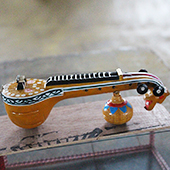Design Resource
Veena Making - Bobbili, Andhra Pradesh
String Instrument
by
Prof. Bibhudutta Baraland Parvathi Pooja
The origin of the Veena can be traced to India's Vedic period. In Hinduism, traditional music has been an integral part of performance arts. Markandeya Purana and many other Puranas have theories of music. It can be found in Natya Shastra, a Sanskrit text credited to sage Bharata Muni. It is the oldest surviving ancient text on classical music and performance arts in which Veena is discussed. The Natya Shastra describes a seven-string instrument and then explains how the instrument should be played. One can always see Saraswathi, the goddess of art, and learning with Veena and a book in her hands. Veena is the favourite instrument of several important deities. The Veena handled by goddess Saraswathi is known as Kachchapi. The size, structure, shape, and tuning have all changed from time to time, and the Veena at each stage has had a different name and has sounded different.
Nowadays, Veena is about 4 feet in length. Its design is made up of a large resonator carved and hollowed out of a log, a tapering neck topped with 24 brass or bell metal frets set in scalloped black wax on wooden tracks, and a tuning box culminating in a downward curve, and an ornamental dragon's head. If Veena is made out of single wood it's called Ekantha Veena. There are four main strings and three subsidiary strings on the Veena. Yedathore Subbaraya Sharma had written and published a book in Kannada' Sandhyavandaneya Thathvartha Vedaprakaashike', which tells the significance of the Veena.
The art of playing the Veena varies from region to region. The style of playing the Veena is called Banis; the four distinct styles known are Thanjavur, Mysore, Travancore, and Vizianagaram. Each of these places produced extraordinary musicians who set trends for others to follow. Each of these artists had styles that were characteristically different from one another and had marked differences. This particular individualistic quality that each performer had to his playing is called 'Bani'. Bani is nothing but a style that is cultivated carefully over some time by a set of people or one person. This style or Bani is then passed over to the next generation of disciples.
Depending on the Bani, the making of a Veena also varies to some extent. Let's take an example of Vizianagaram; Andhra Pradesh also has a tradition of Veena making in a place called Bobbili in the present Vizianagaram district from where the instrument derived its name Bobbili Veena. Bobbili is a place of historical importance as it was once a princely state and was ruled by kings upon a time. The rajas of Bobbili were also patrons of the fine arts. They encouraged Veena making, and in those days, Bobbili produced great musicians. In Bobbili village, a couple of families are into Veena making; the Veena they make are procured by the Craft Development Centre and sold to the outsiders. Now let's see how this Bobbili Veena is made.








